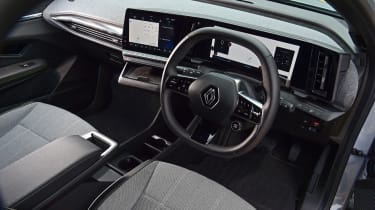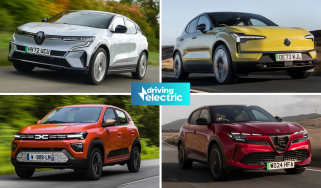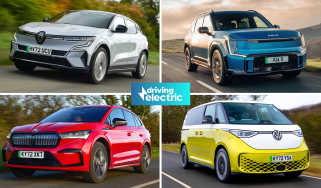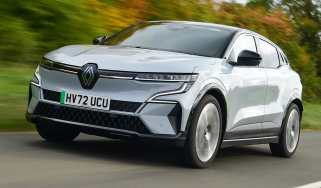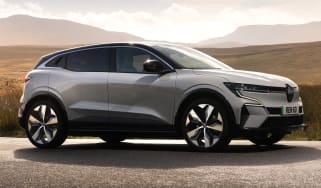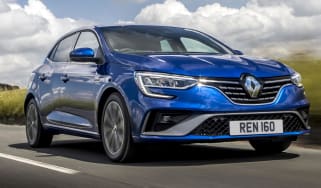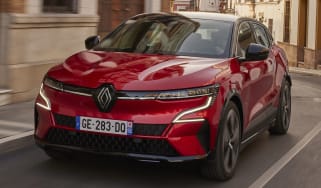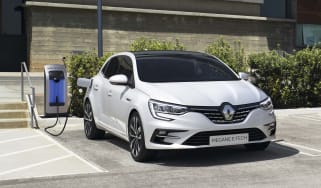Renault Megane E-Tech review
Comfortable, refined and with one of the best infotainment systems in the business: there’s a lot to like about Renault’s electric family car
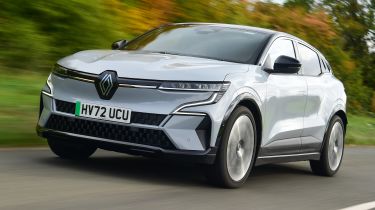
Pros
- Fantastic Google infotainment
- Eye-catching styling
- Comfortable and refined
Cons
- Limited rear visibility
- Rear seats a bit tight
- Interior quality average in places
| Battery size | Range | Wallbox charge time | Rapid charge time |
|---|---|---|---|
| 60kWh | 280 miles | 9hrs 45mins (0-100%, 7.4kW) | 30mins (10-80%, 130kW) |
Renault Megane E-Tech verdict
It’s taken a long time for Renault to launch a follow-up to its hugely successful ZOE supermini, but its new electric family hatchback was well worth the wait. The Renault Megane E-Tech is comfortable, refined and even rather stylish. Plus, its Google-powered infotainment system is one of the best we’ve ever tested – winning our 2023 Technology Award as a result.
The fully-electric Megane tops its key rivals – the Volkswagen ID.3, Cupra Born and MG4 EV – in the practicality department, and its 280-mile range is competitive for this class of EV. Rear space is a little tight compared to some compact SUVs in the same price range, and rear visibility could be better, but the rest of the Megane E-Tech more than makes up for those foibles.
Range details, specs and alternatives
The Renault Megane has been around since 1995, offered in various bodystyles and with a choice of petrol, diesel and more recently, plug-in hybrid powertrains. But now the Megane is electric-only, as Renault begins to launch its next-generation of EVs – a decade after it introduced the practical and affordable ZOE supermini.
The new Megane E-Tech sits on the same EV-specific platform as the Nissan Aryia family SUV that’s also going to be used in the newly-revealed Renault Scenic SUV, which is due to go on sale next year. Some of the technology is going to make its way into the hotly-anticipated Renault 5 hatchback as well, and the new Renault 4 that’s being reborn as a compact SUV.
Rivals to the Megane E-Tech are primarily other electric family hatchbacks. Old rivals like the Honda Civic and Volkswagen Golf are yet to go fully electric, however the plug-in Megane still has to face competition from VW’s newer ID.3, its sister car, the Cupra Born, and the newly-electrified Vauxhall Astra. Our 2023 Car of the Year, the MG4 EV, is also a serious challenger to the Megane E-Tech, as it comes with a similar range and plenty of kit, for a lot less money.
Unlike those cars, the latest Renault Megane has taken on something of a fashionable pseudo-SUV persona which also means it’ll have to fend off a myriad of electric crossovers including the Kia Niro EV, the Hyundai Kona Electric and the much more expensive Honda e:Ny1.
Every Megane E-Tech in the UK is fitted with a 60kWh battery – enough for a range of 280 miles – and a punchy 217bhp electric motor to power the front wheels. The range currently starts from just under £37,000, with a choice of four trim levels – Equilibre, Techno, Techno+ and Iconic – a Launch Edition model was also available, as its name suggests, around the time the Megane E-Tech first went on sale. All models are generously equipped, and feature a nine-inch touchscreen, 12.3-inch digital driver’s display, LED headlights, heated front seats and steering wheel, a reversing camera, wireless Apple CarPlay and Android Auto, plus 130kW rapid charging capabilities.
Click here to see why you can trust DrivingElectric reviews, or for a more detailed look at the Renault Megane E-Tech, read on for the rest of our in-depth review...

